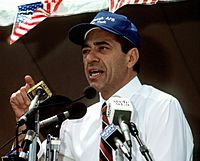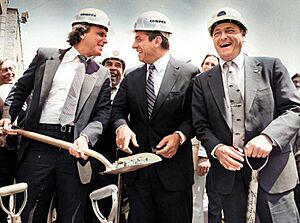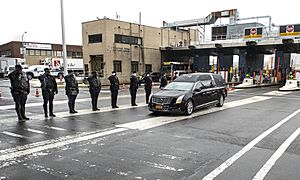Mario Cuomo facts for kids
Quick facts for kids
Mario Cuomo
|
|
|---|---|

Cuomo in 1987
|
|
| 52nd Governor of New York | |
| In office January 1, 1983 – December 31, 1994 |
|
| Lieutenant | Alfred DelBello Warren Anderson (acting) Stan Lundine |
| Preceded by | Hugh Carey |
| Succeeded by | George Pataki |
| Lieutenant Governor of New York | |
| In office January 1, 1979 – December 31, 1982 |
|
| Governor | Hugh Carey |
| Preceded by | Mary Anne Krupsak |
| Succeeded by | Alfred DelBello |
| 57th Secretary of State of New York | |
| In office January 1, 1975 – December 31, 1978 |
|
| Governor | Hugh Carey |
| Preceded by | John Ghezzi |
| Succeeded by | Basil Paterson |
| Personal details | |
| Born |
Mario Matthew Cuomo
June 15, 1932 New York City, New York, U.S. |
| Died | January 1, 2015 (aged 82) New York City, New York, U.S. |
| Resting place | St. John Cemetery |
| Political party | Democratic |
| Other political affiliations |
Liberal Party of New York |
| Spouse | |
| Children | 5, including Andrew, Margaret, and Christopher |
| Education | St. John's University (BA, LLB) |
| Signature | |
Mario Matthew Cuomo (born June 15, 1932 – died January 1, 2015) was an American lawyer and politician. He served as the 52nd governor of New York for three terms, from 1983 to 1994. He was a member of the Democratic Party.
Before becoming governor, Cuomo was the lieutenant governor of New York from 1979 to 1982. He also served as the secretary of State of New York from 1975 to 1978. Mario Cuomo was the father of former New York governor Andrew Cuomo and former CNN news anchor Christopher Cuomo.
Cuomo was well-known for his liberal ideas and powerful public speeches. His most famous speech was at the 1984 Democratic National Convention. In this speech, he criticized the policies of President Ronald Reagan. He famously said, "This nation is more a 'Tale of Two Cities' than it is just a shining 'city on a hill."
Many people thought he might run for president in 1988 and 1992, but he decided not to. Because he often seemed unsure about running for president, he was sometimes called "Hamlet on the Hudson". In 1994, he lost his bid for a fourth term as governor to George Pataki. After that, he left politics and became a lawyer again.
Contents
Early Life and Education
Mario Cuomo was born in Briarwood, a part of Queens, New York City. His family was of Italian origin. His father, Andrea Cuomo, was from Nocera Superiore, and his mother, Immacolata Giordano, was from Tramonti, Campania. His family owned a grocery store in South Jamaica, Queens. Mario went to New York City P.S. 50 and St. John's Preparatory School.
Cuomo was a talented baseball player. In 1952, while attending St. John's University, he signed with the Pittsburgh Pirates. He played as an outfielder for the Brunswick Pirates in a minor league. During a game, he was hit in the back of the head by a pitch. This injury was serious, and he had to stay in the hospital for six days.
After recovering, Cuomo stopped playing baseball. He returned to St. John's University and graduated with high honors in 1953. He then decided to study law at St. John's University School of Law, graduating at the top of his class in 1956. Even though he was a top student, many law firms would not hire him because of his Italian background. He was finally hired by a small law firm in Brooklyn. Cuomo later became a partner at this firm. He also taught law as a professor at St. John's University School of Law.
Early Political Career
Cuomo first became known in New York City in the late 1960s. He helped a group of 69 homeowners in Corona, Queens, who were worried about losing their homes. The city planned to build a new high school there. He also helped other groups in Queens with housing issues. In 1972, New York City Mayor John Lindsay asked Cuomo to help settle a disagreement about public housing in the neighborhood of Forest Hills. Cuomo wrote a book about this experience called Forest Hills Diary.
New York Secretary of State
In 1974, Cuomo ran for Lieutenant Governor of New York. He lost in the primary election. However, the newly elected Governor, Hugh Carey, chose Cuomo to be the Secretary of State of New York. Cuomo served in this role from 1975 to 1978.

New York City Mayoral Election
In 1977, Cuomo ran for Mayor of New York City. The current mayor was not very popular. Cuomo was one of several candidates in the Democratic primary election. He made it to a runoff election against Ed Koch. Koch won the runoff. Cuomo then ran in the general election as the candidate for the Liberal Party.
During the mayoral campaign, Cuomo was against the death penalty. This was not a popular view in New York City at the time because crime rates were very high. Cuomo lost the general election to Ed Koch.
New York Lieutenant Governor
In 1978, the Lieutenant Governor decided not to run for re-election. Cuomo won the primary election for Lieutenant Governor. He was then elected alongside Governor Carey in the general election. He served as Lieutenant Governor from 1979 to 1982.
Governor of New York
Elections for Governor
In 1982, Governor Carey decided not to run again. Mario Cuomo ran for governor. He again faced Ed Koch in the Democratic primary. This time, Cuomo won the primary. He then ran against Republican businessman Lewis Lehrman in the general election. Cuomo won and became the 52nd Governor of New York.

Cuomo actively supported Walter Mondale in the 1984 presidential election. Cuomo was chosen to give the main speech at the 1984 Democratic National Convention. In his famous Tale of Two Cities speech, he strongly criticized President Ronald Reagan's policies. He said, "There is despair, Mr. President, in the faces that you don't see, in the places that you don't visit, in your shining city." This speech made him famous across the country. Many people then saw him as a possible future president.
Cuomo was re-elected governor in 1986 by a large margin. He decided not to run for president in 1988. He was re-elected again in 1990.
Many people wondered if Cuomo would run for president in 1992. He said he had "no plans and no plans to make plans." He was working on the state budget and promised not to announce a presidential run until the budget was settled. Polls showed him doing well in the presidential race. However, he could not reach a budget agreement with the state legislature by the deadline. He decided not to run for president, even though an airplane was waiting to take him to New Hampshire to file his papers. This decision earned him the nickname "Hamlet on the Hudson."
In 1994, Cuomo ran for a fourth term as governor. Republicans criticized him for the state's slow economic recovery and his opposition to the death penalty. Cuomo was defeated by George Pataki. He lost much of his support outside of New York City.
After leaving office, Cuomo appeared in a funny TV commercial for Doritos with Ann Richards, the former Governor of Texas.
Accomplishments as Governor
During his time as governor, Mario Cuomo achieved many things for New York State.
- He created a balanced budget and improved the state's credit rating.
- He worked to stop the federal government from removing tax deductions for state and local taxes.
- He passed important financial reforms and improved ethics rules for the state government.
- Cuomo also helped New York State expand its business connections around the world.
He started the "Decade of the Child" program, which focused on improving healthcare and education for children. He also launched the "Rebuild NY" Transportation Bond Act to fix bridges and roads. Cuomo increased support for local police to fight crime. New York State was also the first state to pass seat belt laws under his leadership.
Cuomo created the Office of the MTA Inspector General (OIG) in 1983. This office acts as an independent watchdog for the Metropolitan Transportation Authority (MTA). He also supported family support programs across the state.
In healthcare, Cuomo worked to lower the cost of prescription medicines for senior citizens. He also led a strong public health plan to deal with the AIDS epidemic. Cuomo was dedicated to protecting the environment. New York State was the first to combine environmental protection with energy saving goals.
Cuomo also made history with his appointments to the New York Court of Appeals, the state's highest court. He appointed the first two female judges, as well as the first African-American and Hispanic judges to the court.

Political Views
Mario Cuomo was known for his liberal political views. He was strongly against the death penalty. This was an unpopular opinion in New York during the 1980s and early 1990s when crime was high. As governor, he vetoed several bills that would have brought back capital punishment in New York. The death penalty was later brought back by Governor Pataki, but it was never used and was eventually ruled unconstitutional.
Cuomo also spoke out against the unfair way Italian Americans were sometimes shown in the media, especially being linked to the Mafia. He urged the media to stop using the word "mafia."
He also supported the Buffalo Bills football team, calling them "New York State's only team." He did not like that the New York Giants and New York Jets football teams moved to New Jersey.
After Being Governor
After leaving office in 1995, Mario Cuomo worked as a lawyer at a firm in New York. He also joined the board of several companies.
Books by Cuomo
Mario Cuomo wrote several books. His first book, Forest Hills Diary: The Crisis of Low-income Housing, was important in political science and housing policy. In 1996, he wrote Reason to Believe. He also wrote an essay about his parents' journey to America called "Achieving the American Dream." He wrote Why Lincoln Matters in 2004 and helped edit Lincoln on Democracy, a collection of Abraham Lincoln's speeches.
Honors and Awards
In 1983, Barnard College gave Mario Cuomo its highest honor, the Barnard Medal of Distinction. Yeshiva University also gave him an honorary law degree that year.
In 2017, the new Tappan Zee Bridge was officially named the "Governor Mario M. Cuomo Bridge" in his honor.
Family Life
Mario Cuomo was married to Matilda Raffa for 60 years, from 1954 until his death in 2015. They had five children: Margaret, Andrew, Maria, Madeline, and Christopher. In 2017, Matilda was honored by being included in the National Women's Hall of Fame.
His older son, Andrew, married Kerry Kennedy, a daughter of Robert F. and Ethel Skakel Kennedy. Andrew served as Secretary of Housing and Urban Development under President Bill Clinton. He later became the New York State Attorney General and then was elected Governor of New York in 2010. He served as governor for ten years.
His younger son, Chris, became a journalist. He worked for ABC Network and later for CNN, where he hosted his own show.
His daughter Maria is married to fashion designer Kenneth Cole. She leads a charitable foundation called HELP USA.
His daughter Margaret is a doctor specializing in radiology. She is also a national advocate for preventing cancer, heart disease, and diabetes. She wrote a book called A World Without Cancer (2013).
Mario Cuomo remained a big baseball fan throughout his life. He enjoyed watching baseball games and was even featured in the Ken Burns PBS series Baseball.
Illness and Death
On November 30, 2014, it was announced that Mario Cuomo had been hospitalized for a heart condition. He was described as being in good spirits.
On January 1, 2015, his son Andrew Cuomo was sworn in for his second term as governor. Mario Cuomo was too ill to attend the ceremony. He died from heart failure at his home in Manhattan later that day, at the age of 82.
Cuomo's funeral was held on January 6, 2015, at Saint Ignatius Loyola Church in Manhattan. He is buried at St. John Cemetery in Middle Village, Queens.
Reactions to His Death
Many important leaders shared their thoughts after Cuomo's death. President Barack Obama said that Mario Cuomo, "An Italian Catholic kid from Queens, born to immigrant parents, Mario paired his faith in God and faith in America to live a life of public service." Vice President Joe Biden called Cuomo "a forceful voice for civil rights, for equal rights, for economic opportunity and justice." Former New York Governor George Pataki remembered him as "a proud son of immigrants and a compassionate leader." Former New York City Mayor Rudy Giuliani said, "Mario was a giant political influence of his generation."
Legacy
Mario Cuomo is remembered as a very important New York politician from the late 1970s and 1980s. He was also known for his amazing public speaking skills.
The new Tappan Zee Bridge was renamed the Governor Mario M. Cuomo Bridge in his honor.
His legacy also continued through his family, especially with his son Andrew Cuomo being elected Governor of New York in 2010. Andrew Cuomo served as governor for ten years.
See also
 In Spanish: Mario Cuomo para niños
In Spanish: Mario Cuomo para niños




